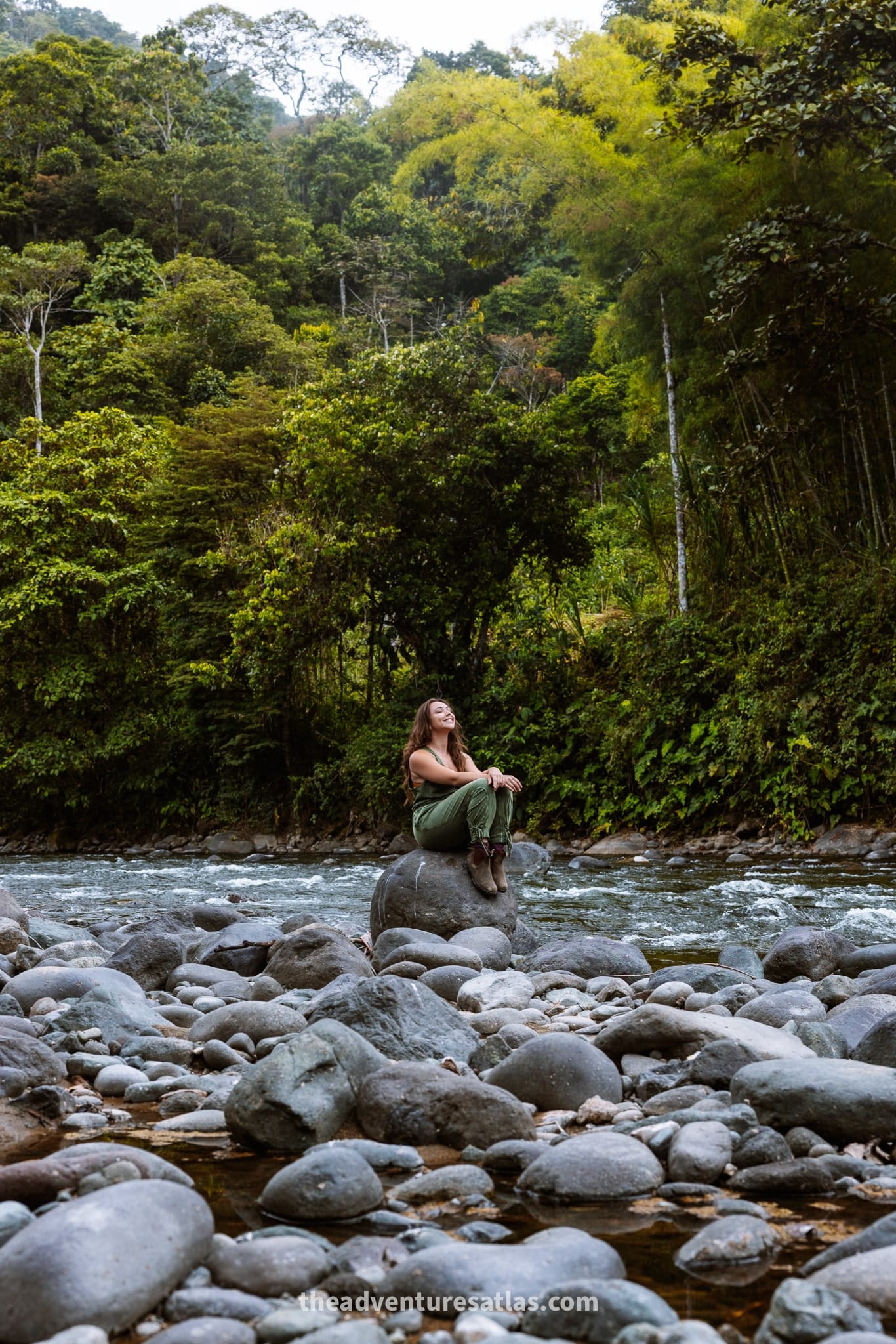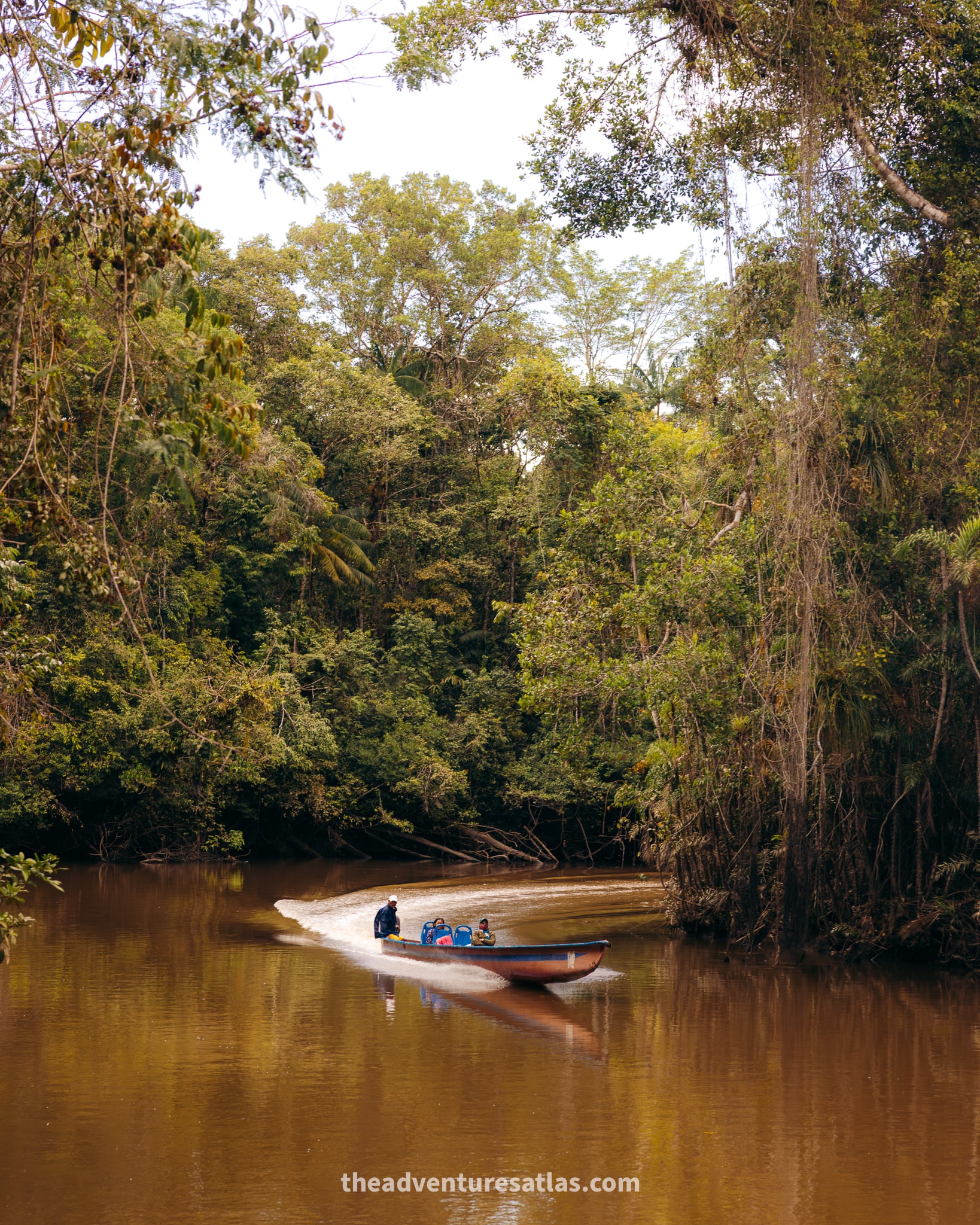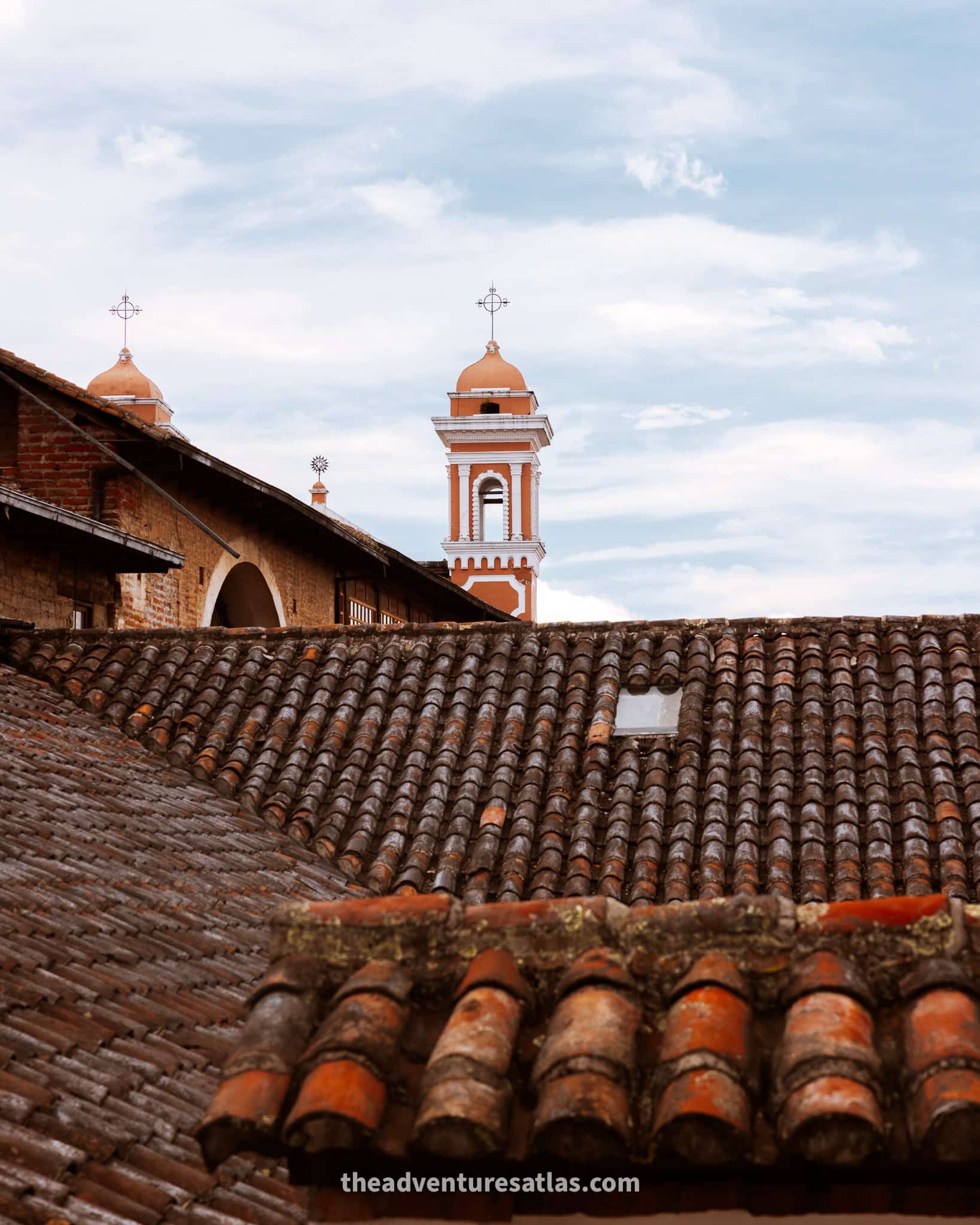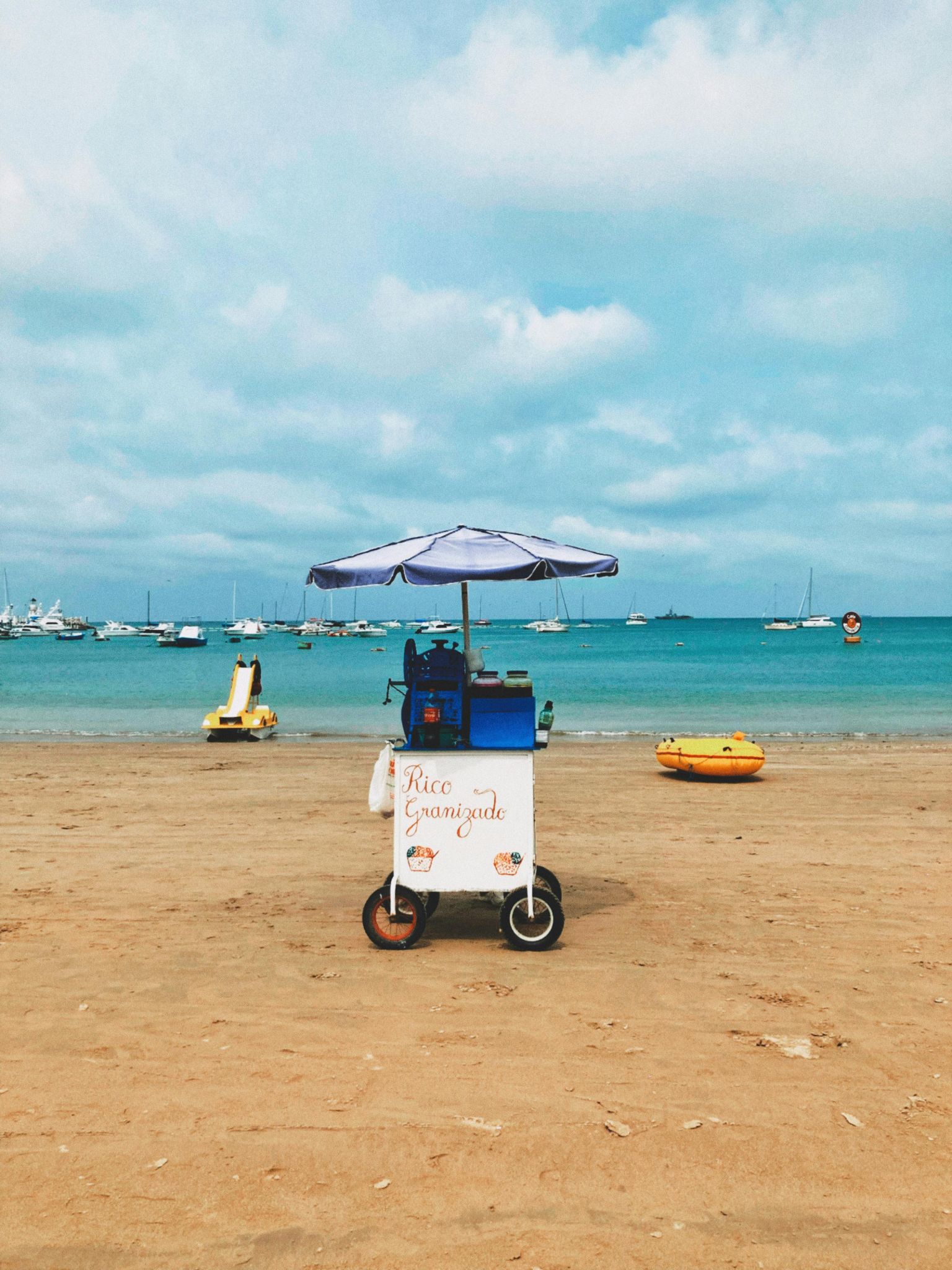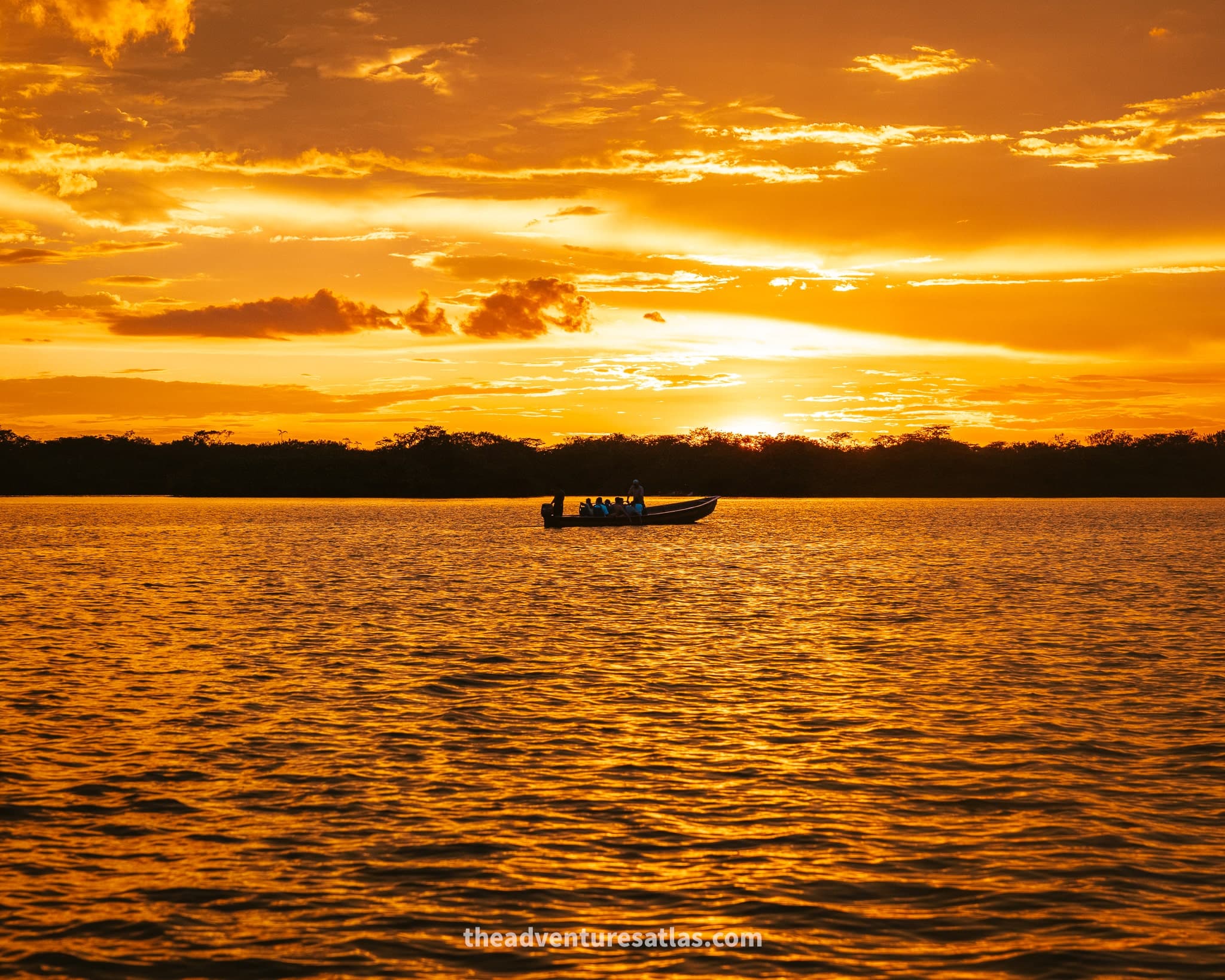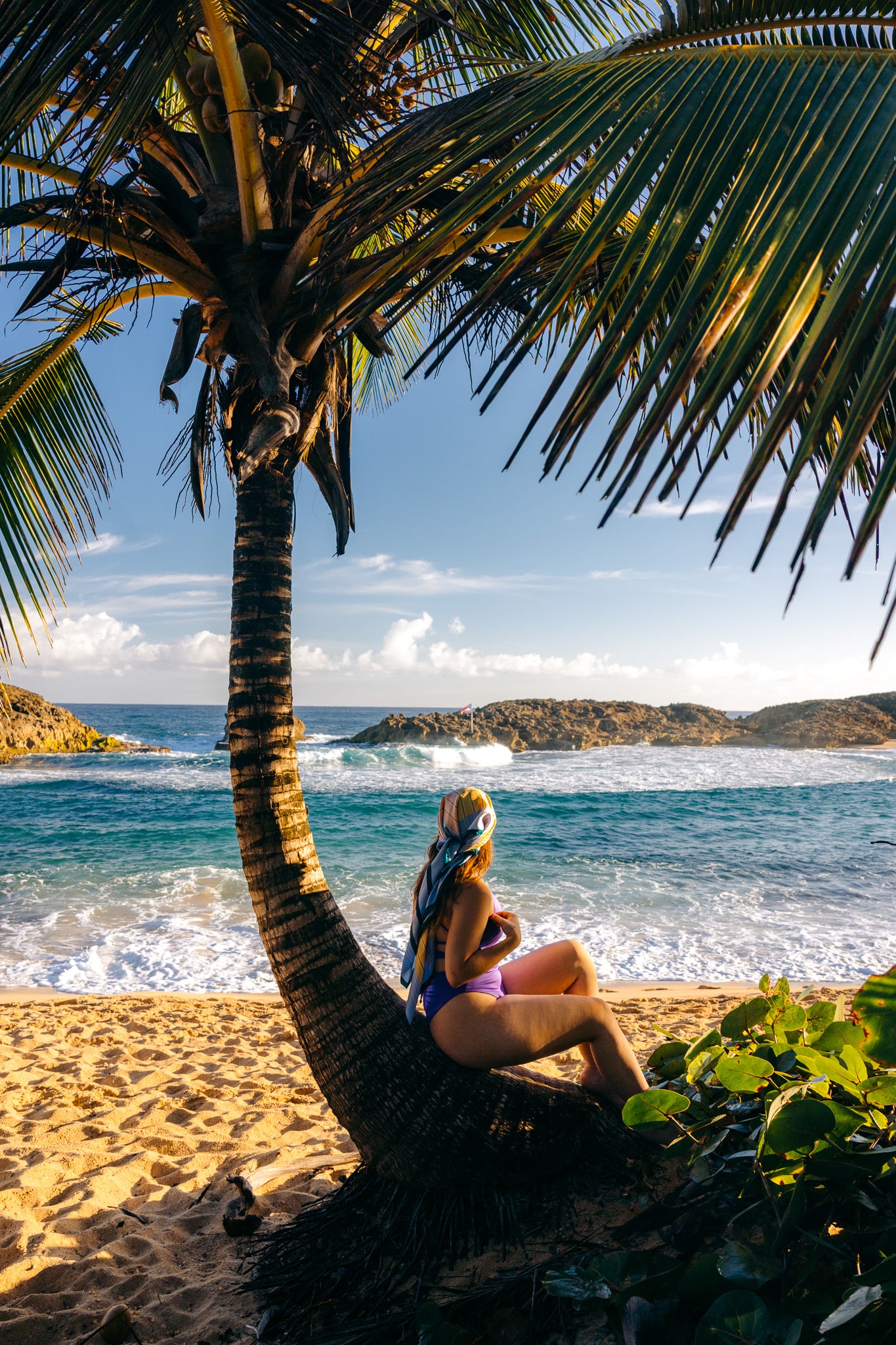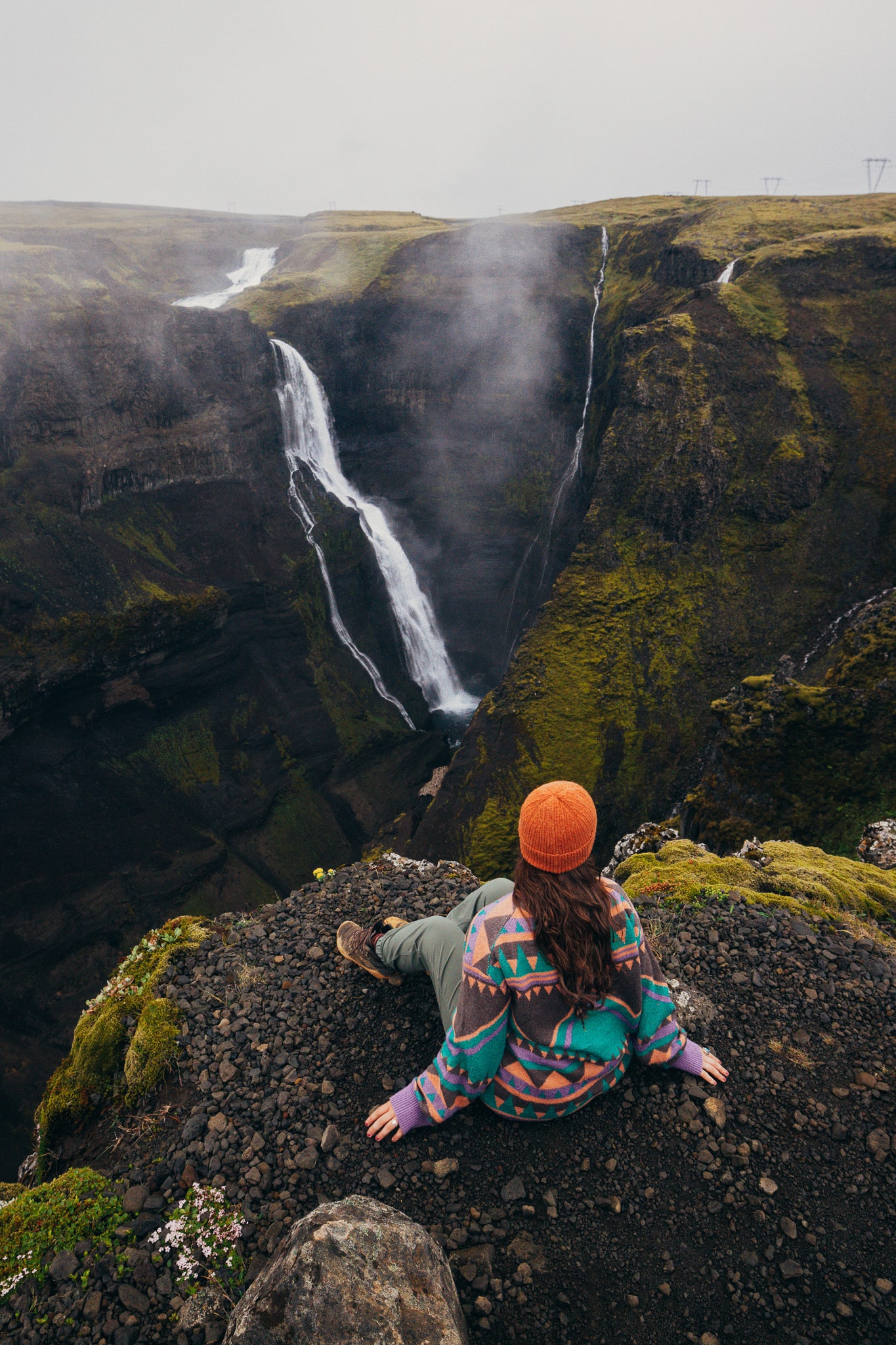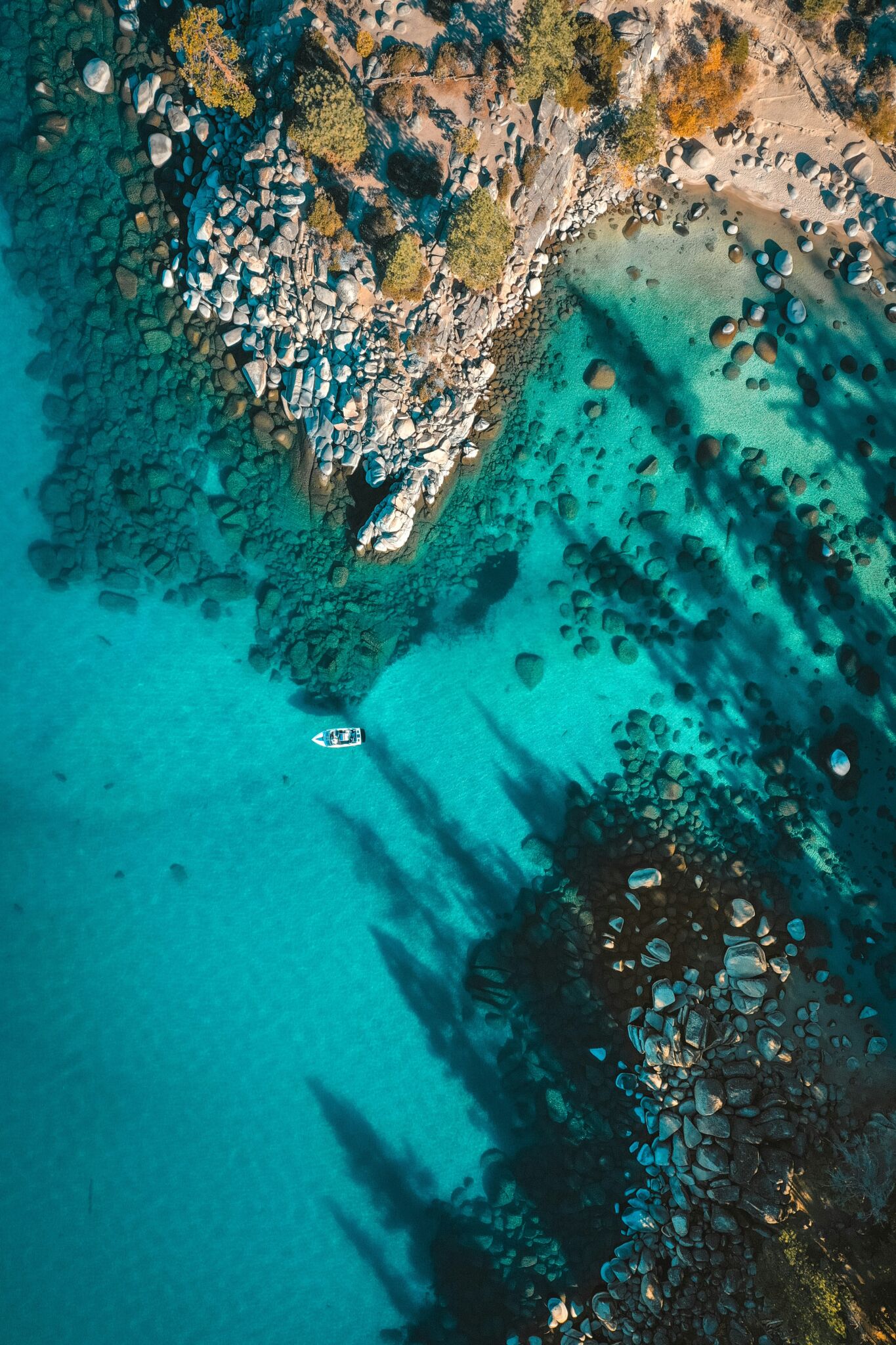The 15 Best Places to Visit in Ecuador
Post summary: The best places to visit in Ecuador for vacation and the best Ecuador tourist attractions
Ecuador might be one of South America’s smallest countries, but it’s also one of the most diverse.
After spending over two weeks road tripping this incredible place, I can confidently say that it’s very highly underrated and worth adding to your bucket list.
Packed into a country about the size of Colorado, Ecuador has active volcanoes, pristine Pacific beaches, mystical cloud forests, and some of the most biodiverse jungle on the planet. It’s one of those rare places where you can experience multiple ecosystems and climates all within a few hours’ drive of each other.
You can hike active volcanoes, visit the Amazon, immerse yourself in rich Indigenous culture up in the highlands. Or simply eat your way through the country (please trust me when I say that the food scene is AMAZING).
Here are the 15 best places to visit in Ecuador that should be on your radar, based on my own experience!
Planning your first trip to Ecuador? Don’t miss my guide to essential things to know about Ecuador before you go – it’ll save you time and help you avoid common mistakes.
Posts to help you prepare for your trip
How to Use Google Maps to Plan Your Next Road Trip (Step-By-Step Tutorial With Examples)
15 Useful Apps to Download Before Your Next Road Trip (for Free!)
What to Pack for a Day Hike: Essential Gear and Complete Packing List

The 15 Best Places to Visit in Ecuador
1. Galápagos Islands: Best Place in Ecuador for Vacation
The Galápagos Islands are unlike anywhere else on Earth.
As you probably learned in school, this UNESCO World Heritage archipelago is where Charles Darwin developed his theory of evolution, and when you get there yourself, you’ll understand why this is one of the best tourist attractions in Ecuador.
What makes the wildlife encounters here so special is that the animals have no fear of humans. Because they evolved without natural predators and had limited human contact for centuries, you can get incredibly close to species found nowhere else on earth.
This is also the only place in the world where you can see penguins swimming over coral reefs! It’s a completely surreal experience that perfectly captures the uniqueness of these islands.
How to visit: The best way to access the more remote islands and see the most wildlife is on a multi day cruise. However island hopping tours from Puerto Ayora work well if you’re on a tighter budget. Just know that the Galápagos are expensive either way. It’s worth it, but budget accordingly.
2. Historic Quito (Centro Histórico)
Quito’s historic center is hands down one of the top tourist attractions in Ecuador because it’s one of the best preserved colonial areas in Latin America.
Walking the cobblestone streets feels like stepping back in time. Kind of like being in a museum, but it’s actually a real city center.
We spent two full days here at the start of our Ecuador road trip to acclimate and get our bearings. While I wish we stayed a little longer, 2 full days felt like enough time since we had so many other things planned. But if you have more time, there are a lot of popular tourist attractions here and you could easily spend 3-4 days just exploring the historic city center.
Here’s what I’d recommend:
Start your trip at Plaza Grande, where you can see the Presidential Palace and the impressive Quito Cathedral.
Don’t miss La Compañía de Jesús church, which is covered in so much gold leaf it practically glows when the light hits it right.
For the best view of the city, take a taxi up to Panecillo Hill for panoramic views of Quito nestled between the Andes Mountains. I can’t stress this enough, though – don’t walk up there as the route up the stairs isn’t safe (even for locals). Always take a taxi or join an organized tour!

Outside the historic center, Quito has a surprisingly great food scene and makes the perfect base for exploring the rest of Ecuador.
Fair warning: The altitude hits hard at 9,350 feet above sea level. Take it easy your first day, drink lots of water, and don’t be surprised if you feel winded walking uphill.
Planning to stay a few days? Check out my complete guide 10+ Best Places to Stay in Quito for different budgets and travel styles.
3. Cotopaxi National Park
You absolutely cannot visit Ecuador without seeing Cotopaxi National Park.
Located about 2 hours south of Quito, this park protects one of the world’s highest active volcanoes and easily one of the most photogenic peaks I’ve ever seen.

Cotopaxi volcano is a nearly perfect cone shape and rises majestically above páramo grasslands. It stays covered with snow all year round, which makes it extra unique. The only other volcano in the world with a similar perfect cone is Mt. Fuji in Japan.
Hiking to the Jose Rivas Refugio at 15,744 feet is easily one of the coolest things to do in Ecuador. You can also bike down volcanic slopes, or just take in the incredible views from various viewpoints throughout the park.
Cotopaxi is one of the best day trips from Quito, but I highly recommend staying longer if possible to really explore the area without feeling rushed.
We were glad that we spent 2 full days in Cotopaxi because the weather can be unpredictable and completely fog out the volcano. The longer you spend, the better chance you have of seeing it without clouds!
Read more: My complete guide to the best things to do in Cotopaxi National Park covers hiking routes, viewpoints, and whether you need a guide.
4. Best Places to Visit in Ecuador: Mindo Cloud Forest
Mindo sits in Ecuador’s mystical cloud forest about 2 hours from Quito, and it feels like entering a completely different world from the highlands. This small mountain town is one of the best places in Ecuador to book an eco-lodge and relax in nature.

The town itself is very small, but it’s surrounded by incredibly biodiverse forest that’s home to over 400 bird species, including colorful toucans, tiny hummingbirds, and the elusive cock-of-the-rock. Even if you’re not into birding, the sheer diversity of wildlife here is incredible.
You can also zip line through the forest, go tubing down rivers, hike to hidden waterfalls, or taking guided night walks to spot nocturnal creatures you’d never see during the day.
Whatever you do – don’t skip the chocolate tours! Mindo is known for its local cacao farms where you can see the entire process from bean to bar and taste some of the best chocolate you’ll ever have. El Quetzal Restaurant is one of the best places to take a tour, plus take one of their famous brownies to go.
PS: I wrote a full guide to the best things to do in Mindo, Ecuador!
5. Baños: Ecuador’s Adventure Capital
Baños has earned its reputation as the top adventure capital of Ecuador. Tucked between the Andes and Amazon, this energetic little town is the best place to go in Ecuador for world class adventures.

These are the coolest things to do on a trip to Baños:
- Bike the Ruta de las Cascadas (Waterfall Route), a scenic ride that takes you past several spectacular waterfalls and ends at the famous Pailón del Diablo waterfall.
. - Visit Casa del Árbol is to see the famous “Swing at the End of the World.” For just $1, you can swing out over a dramatic valley with Tungurahua Volcano as your backdrop. Go in the morning or on clear days for the best views and photos, since clouds tend to roll in around the afternoon.
.. - Soak in the natural hot springs. Luna Volcán is my favorite and one of the coolest places we saw in Ecuador. It’s $20 per person for a spa pass, so definitely pricier and more touristy than other options but the valley views are unmatched. Termas de la Virgen and El Salado are more local, budget friendly public options around town.
. - Book an adventure tour like ziplining over deep canyons, canyoning down waterfalls, mountain biking through cloud forest, white water rafting, and bungee jumping (if you’re truly brave). Baños is a very popular tourist attraction in Ecuador, so most hotels can help you book activities or you can easily arrange them through the many tour operators in town.
6. The Amazon Rainforest: Three Ways to Experience the ‘Lungs of the World’
The Amazon rainforest is one of the most iconic and vital ecosystems on Earth and spans across 9 countries in South America, including Ecuador.
The Ecuadorian Amazon ‘Amazonia’ is one of the most biodiverse places on Earth, covering a huge swath of eastern Ecuador teeming with wildlife, eco-lodges and remote indigenous cultures.

What we loved about the Ecuadorian Amazon is that it’s so easy to access, relatively affordable, and home to some of the best protected areas in the entire Amazon Basin: Yasuní National Park and Cuyabeno Wildlife Reserve.
In Ecuador, you have several different ways to access the Amazon depending on your travel style and budget.
Cuyabeno Wildlife Reserve: The Ultimate Remote Experience
Cuyabeno is a wild, very remote, pristine nature reserve packed with wildlife. Out of all the ways to see the Amazon in Ecuador, this is definitely the most adventurous experience.
This is the option we chose because we were told you have higher chance of seeing wildlife because the river are narrower than in other areas of the Amazon. We also loved the backpacker vibe and had such an awesome time with our group!

In Cuyabeno, you’re pretty much guaranteed to spot pink river dolphins playing in the dark waters, hear howler monkeys calling from the canopy, watch sloths moving in slow motion through the trees, and see countless bird species.
I’d also recommend choosing Cuyabeno because it needs your help. Oil drilling continues to encroach on the edges of the reserve, putting its delicate ecosystems and Indigenous communities at risk. By visiting Cuyabeno, you’re not just exploring one of the most incredible corners of the Amazon, but you’re helping protect it.
Sustainable tourism here plays a vital role in supporting local guides, eco lodges, and conservation efforts that are fighting back against big oil companies. If you want your travel to have a positive impact, Cuyabeno is the place to go.
Getting to Cuyabeno takes commitment. The most popular way to get to get there is via a 10 hour overnight bus from Quito to Lago Agrio, then a short drive to the river where you’ll hop into a motorized canoe for the 2-3 hour journey to the jungle lodges. It’s not easy to reach, but the remoteness is exactly what makes this trip feel so special, adventurous, and untouched.
Yasuni National Park: The Most Biodiverse Place in the World
Yasuní is the most famous way to see the Ecuadorian Amazon. It’s internationally famous because of its record breaking biodiversity and status as a UNESCO Biosphere Reserve.
If Cuyabeno is for backpackers and adventure lovers, think of Yasuní like its more luxurious counterpart.
Yasuní has some higher-end eco-lodges (like Napo Wildlife Center or La Selva Lodge) that offer a more comfortable, all-inclusive jungle experience. It’s your best option if you want a full vacation in the Ecuadorian Amazon.

While you can see a lot of wildlife in Cuyabeno because of how narrow the rivers are, you have a better chance to see larger/rarer species in Yasuní, especially near the Napo River.
Tours of Yasuní often highlight a deeper cultural aspect and experiences with Indigenous communities.
✈️ How to get to Yasuní: Requires a flight from Quito to Coca, followed by a long motorized canoe ride (sometimes 2–4 hours) to reach your lodge deep in the forest.
Tena: The Accessible Amazon Gateway
If you’re short on time or budget, Tena is the easiest way to visit the Amazon in Ecuador.
Known as the “Gateway to the Amazon,” this small jungle town lets you have rainforest adventures without long travel days into remote reserves and multi-day tours.
From Tena, you can go white-water rafting, hike jungle trails, explore caves, visit local Indigenous communities, or join guided day tours. While it’s not as wild or remote as Cuyabeno or Yasuní, you’ll still see wildlife and get a genuine feel for life in the Amazon.
No matter which part of the rainforest you explore, you’ll leave with a deeper appreciation for the ecosystem and a better understanding of why protecting it matters.
7. Lake Quilotoa
Laguna Quilotoa (Quilotoa Lake) is one of those places that stops you in your tracks.
This stunning turquoise lake formed when the Quilotoa volcano erupted and collapsed, creating a giant crater lake that looks almost too beautiful to be real.
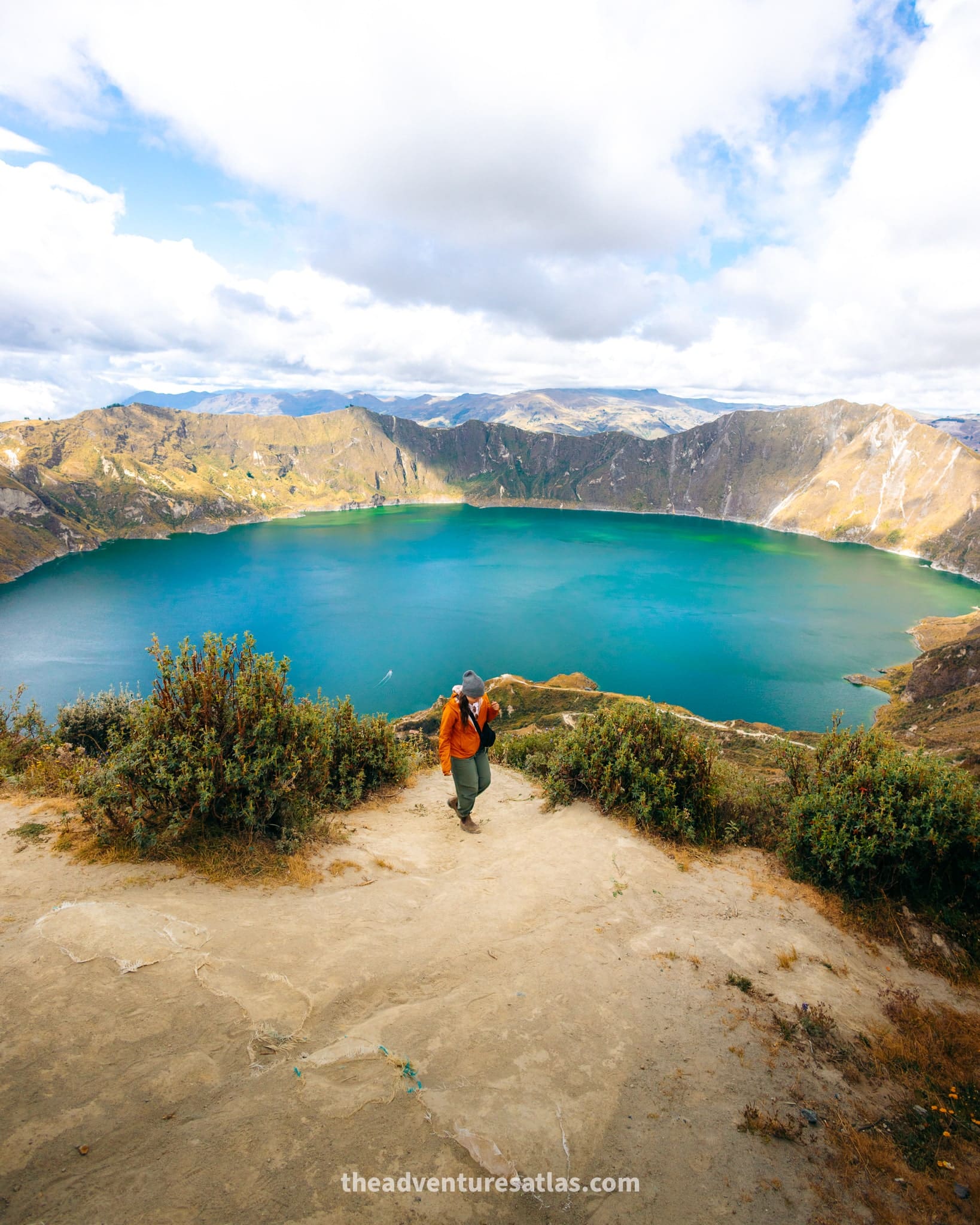
Quilotoa is one of the top tourist attractions in Ecuador, located in a remote mountain village in the Andes. It takes about 3 hours to get here from either Cotopaxi or Baños and makes a great day trip or pit stop on an Ecuador road trip.
Entrance costs just a few dollars, and bring a warm jacket – it gets cold up there even on sunny days!
You can hike portions of the 7.5 mile loop that goes around the crater rim for incredible panoramic views, or take the shorter but steeper trail down to the water’s edge. The trail down is sandy and manageable, but the climb back up is genuinely tough, especially with the high altitude.
Important note: You’ll see people offering mule rides back up from the lake, but please skip this! The animals are often overworked and not well cared for. If you’re not sure about the climb back up, the viewpoints along the rim actually offer better views than from the bottom.
8. Avenue of the Volcanoes: The Most Scenic Drive in Ecuador
If you’re road-tripping through Ecuador, the drive between Quito and Cuenca takes you along the Avenue of the Volcanoes. This is one of the most spectacular scenic routes I’ve ever driven.

This incredible stretch runs along the spine of the Andes Mountains. Along the way you’ll pass major peaks including Chimborazo (the highest mountain in Ecuador) and the perfectly symmetrical Cayambe volcano.
Driving this route gives you incredible views without needing to actually climbing these peaks. The scenery changes around every bend, and there are small towns, local markets, and shorter hikes to explore along the way.

9. Cuenca
Cuenca is one of those cities that makes you want to slow down and stay longer than planned. It has a relaxed, creative vibe and an excellent food scene that makes it the most popular place in Ecuador for expats.
This UNESCO World Heritage site has perfectly preserved colonial architecture, cobblestone streets and plazas filled with flowers, all set beautifully along the Tomebamba River.
The historic center is compact and walkable with tons of beautiful churches, interesting museums, and local artisan shops. The Pumapungo Museum is a must see and covers everything from ancient Incan ruins to modern Ecuadorian culture.
Here’s a fun fact: Cuenca is the birthplace of the famous Panama hat, which (despite its name) is actually made in Ecuador. You can visit local workshops to see how these hats are woven by hand using traditional techniques.
10. Otavalo Market for Indigenous Culture and Artisan Crafts
Visit Otavalo for one of the most authentic cultural experiences in Ecuador. This charming Andean town is surrounded by volcanoes and is home to the largest Indigenous market in South America.

The Otavalo Market happens daily in Plaza de Ponchos, but the best time to visit is on Saturday or Wednesdays for the biggest and best selection of goods. Hundreds of vendors fill the square with colorful textiles, handmade jewelry, pottery, traditional foods, and beautiful leather goods.
Even if you’re not shopping, it’s worth visiting for the energy and vibrant colors, plus the chance to see traditional Indigenous dress and customs that are very much alive today.

The surrounding area is equally beautiful with places like Peguche Waterfall, Lake Cuicocha, and Mojanda Lakes, which are perfect for hiking and photography.
You can easily visit Otavalo on a day trip from Quito, but I recommend staying overnight to explore more of the region.
11. Ingapirca Ruins: The Best Place to Visit in Ecuador for Inca Ruins
Ingapirca is Ecuador’s largest Inca ruins and the most important archaeological site in the country. While it’s not as famous Machu Picchu, it gives you fascinating insights into pre-Columbian history (and it’s a lot less crowded).
What makes Ingapirca unique is the fascinating mix of Inca and Cañari architecture, as these two cultures came together at this site.
The highlight here is the Temple of the Sun, which was carefully constructed and aligned to catch the sun’s rays during solstices. I’m always so impressed with about how much ancient civilization knew about astronomy.
PS: If you love ancient civilizations in South America, you’ll love my photo journal of our time on Easter Island in Chile.
12. Best Beach Destinations in Ecuador
It’s no secret that the Galápagos usually steal the spotlight, but the coast of mainland Ecuador also has some great beach destinations with laid back vibes and a much more budget friendly price tag.
Salinas, Ecuador
Salinas feels like you dropped a slice of Miami Beach straight into South America.
This developed beach resort town has high rise condos, wide sandy beaches, and resort style amenities that makes a great place to vacation in Ecuador for families. Think jet skiing, parasailing, beachfront restaurants, and pool areas.

It’s one of the most developed beach destinations in Ecuador and especially popular with locals from Guayaquil who visit on weekends.
It’s not the most culturally authentic spot in Ecuador, but you’ll like it if you want an accessible beach getaway with swimming, water sports, and all the convenience that comes with staying at a resort.
Montañita, Ecuador
If you’re looking for a spot for a relaxed beach vacation in Ecuador, head to Montañita. This Ecuador beach town is known for world class surfing, vibrant nightlife, and a backpacker vibe.
During the day, people hit the waves (it’s one of Ecuador’s best surf spots), practice yoga or explore the bohemian town center. At night, the beach bars and clubs come alive, especially on weekends when the party can go until sunrise.
It’s definitely not a luxury destination and can get quite loud, especially in the town center. But if you like to meet other travelers, catch epic waves, or just want a super casual beach break, Montañita can be a fun stop for a day or two.
Manta, Ecuador
Manta isn’t your typical “tropical paradise” beach town. It’s a working port city in Manabí Province that has a more authentic coastal vibe without the party scene of Montañita or resort feel of Salinas.
The beaches are decent (especially Playa Murciélago), but you’ll want to come here for the food. This is hands down one of the best places in Ecuador to try fresh tuna, ceviche, and other seafood.
Manta is also a gateway to nearby attractions like Santa Marianita for kitesurfing, and Pacoche Forest for easy hiking trails and wildlife.
Important safety note: Some coastal areas in Ecuador have experienced increased crime recently. Avoid Guayaquil and the entire Esmeraldas province. The beach towns mentioned above are still relatively safe to visit for tourists, but stick to well traveled areas, don’t walk alone at night, leave valuables locked in your hotel safe, and ask locals for current safety updates.
13. Chimborazo
Chimborazo is Ecuador’s highest mountain at 6,263 meters (20,549 ft). And thanks to the bulge in the Earth’s equator, the summit of Chimborazo is actually the closest point the planet to the sun (even closer than Everest!).
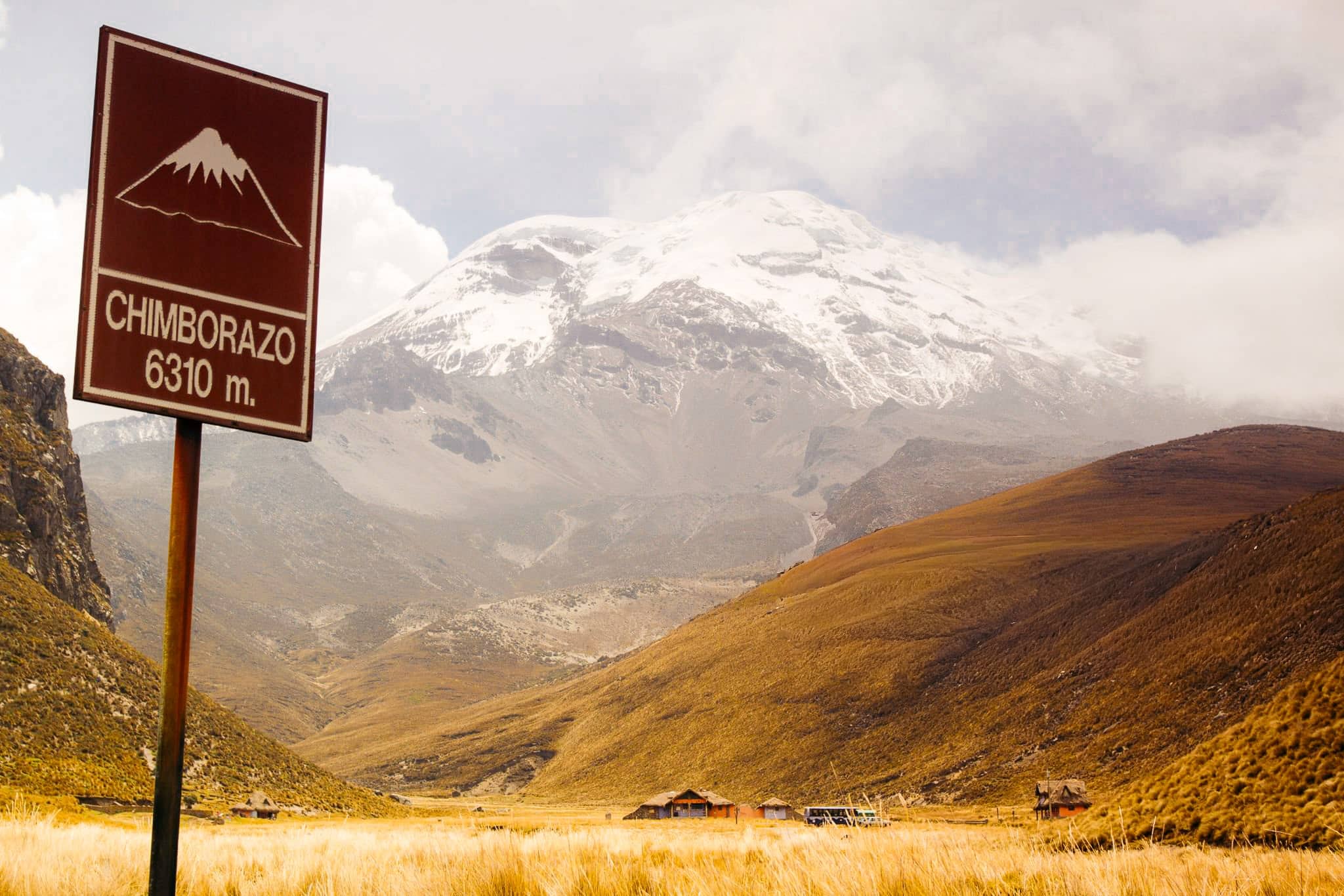
You can only climb to the top of Chimborazo if you’re a super experience mountaineer. But, similar to Cotopaxi, most people can drive up to the first refugio. It sits around 15,000 ft and gives you sweeping views of the peak and the surrounding páramo grasslands.
Keep an eye out for wild vicuñas grazing in the grasslands! They’re relatives of llamas and a rare sight in Ecuador.
14. Papallacta Hot Springs: Natural Relaxation
After a trip full of hiking and adventure, there’s nothing better than soaking in the Papallacta Hot Springs.
Located just 1.5 hours from Quito, these thermal pools sit in a gorgeous mountain valley and are the perfect spot to give your tired muscles a break.

The pools are naturally heated by nearby volcanoes, and the mineral rich water is said to have all kinds of healing benefits. Whether or not that’s true, sitting in steaming pools surrounded by Andean peaks is about as relaxing as it gets.
There are a few different complexes to choose from, including basic public pools to a full spa experience. So you can make it as simple or as fancy as you want. Either way, it’s one of the easiest and most rewarding day trips from Quito.
15. Riobamba: Gateway to Chimborazo
Riobamba is your home base for visiting Chimborazo, but it’s also worth a stop on its own.
The city has a more authentic, everyday feel compared to the other tourist attractions in Ecuador. Here you’ll find a lively central plaza, local markets, and far fewer crowds than larger cities.

This is also where you can hop on the famous Devil’s Nose train, one of the most scenic rail journeys in South America. The train winds through dramatic Andean landscapes and gives you a glimpse of Ecuador’s railway history along the way.
Beyond that, Riobamba is surrounded by volcanoes and makes a great base for exploring the central highlands if you’re looking to get off the typical tourist trail (which I highly recommend).
Best Time to Visit Ecuador
The beauty of Ecuador is that you can visit year round thanks to the huge variety of microclimates across the country. We asked a local guide what he would recommend as the best time of year to visit Ecuador and he said “the best time only depends on what region you want to see”. So, here’s a quick overview to help with your planning:
- For the highlands (Quito, Cotopaxi, Cuenca): June through September is the dry season with the clearest skies and best weather for hiking.
. - For the Amazon rainforest: Chances of seeing wildlife are highest in the rainy season, which is usually December – May, but you’ll obviously need to expect almost daily rain (and it rains A LOT).
. - For the Galápagos Islands: Any time works, but seas are calmer between December and June, if you’re extra prone to seasickness.
We took our Ecuador vacation in September and found it to be the sweet spot for great weather in both the highlands and rainforest regions. You get clear mountain views and active wildlife without the peak season crowds.
Ecuador Travel Guide: Essential Planning Information
A lot of this is already broken down in my post on 19 Important Things to Know About Ecuador Before You Go, but here’s a quick overview of how to get around and a high level overview of what to know for your trip:
How to Get Around Ecuador
One of the best things about Ecuador is how easy it is to get around. The whole country is super small, so you can cover a lot in a shorter period of time and you have a lot of options for transportation:
-
Rental car: Best if you want the freedom to stop at small towns, scenic viewpoints, and hidden spots along the way. City traffic can be hectic, but highways between major destinations are in surprisingly good shape!
-
Buses: This is the most budget friendly way to travel. Long distance tourist buses like Flota Imbabura and Cooperativa de Transportes Ecuador are cheap and run regularly between cities. Stick to tourist buses and avoid “chicken buses”/inner city buses if you can because they tend to be a hotspot for pickpockets.
-
Organized tours: The best option if you want to use Quito as a home base and just take day trips or for activities with tricky logistics like visiting the Amazon or Galápagos cruises. In these cases, it’s just easier to let someone else handle the planning.
-
Domestic flights: Mainly used for the Galápagos or to get to Yasuni. Most mainland destinations are easily reachable by road.
My take: If you’re sticking to mainland Ecuador, tourist buses and rental cars are the best way to get around. For rental cars, avoid international companies at the airport because they oversell their cars and can turn into a giant headache. We went with a local company, Amigo Car Rental EC, instead and had the easiest time from start to finish!

Ecuador Travel Tips for First Time Visitors
Currency: Ecuador uses the US dollar so paying for things and budgeting is extra easy if you’re coming from the US
Language: Spanish is the official language of Ecuador. Learning basic phrases is very helpful, especially outside major tourist areas.
Altitude: Many destinations are at high elevation. Take it easy your first day in places like Quito and Cotopaxi, drink lots of water, and consider altitude sickness meds if you’re sensitive.
Tipping: 10% is standard at restaurants, but the tip is usually already included in your bill. Tipping is most common for guides, drivers, tours, etc. We tipped 10-20% for guides and tours and a few dollars for Uber drivers. It’s not expected, but it does go a long way and makes a big difference for service workers!
Internet: Connection was actually a lot better than we thought it would be throughout the country. WiFi is widely available in hotels and restaurants in tourist areas.
What to Pack for Ecuador
Ecuador’s diverse climates mean you need to pack for basically everything. Here’s what I recommend based on my experiences:
Essential clothing:
- Layers for temperature changes (especially in the mountains)
- Quality rain jacket for sudden showers
- Waterproof hiking boots for trails and wet conditions
- Swimsuit for hot springs, beaches, and Galápagos
- Warm hat and gloves for high altitude areas
Important accessories:
- Strong sunscreen (UV is intense at high altitudes)
- Bug spray for Amazon and coastal areas (extra important to protect against dengue and yellow fever!)
- Daypack for hikes and day trips
- Power bank for long days out
- Small bills in USD for markets and small vendors
Health items:
- Altitude sickness medication
- Basic first aid supplies
- Any prescription medications you need

Ecuador Safety Tips
Ecuador is generally safe for travelers if you use common sense. Here’s what I learned during my time there:
General safety:
- Be aware of pickpockets and tourist scams in popular areas like Quito’s historic center
- Don’t flash expensive electronics or jewelry!
- Use official taxis or Uber in cities
- Ask locals about current conditions in areas you plan to visit
Hiking safety:
- Stick to marked trails and let someone know your plans
- Weather can change quickly in the mountains, so be prepared
- Consider hiring local guides for more remote areas
Coastal areas:
- Some regions have increased crime – research current conditions before you go
- Avoid Guayaquil and Esmeraldas province entirely
- Stick to well-traveled beach towns and tourist areas
Frequently Asked Questions About Visiting Ecuador
How many days do you need in Ecuador?
It depends on what you want to see, but here are my recommendations based on how much time you have:
- One week: Focus on 3-4 mainland destinations like Quito, Cotopaxi, Baños, and Mindo. Alternatively, dedicate the entire week to the Galápagos or Amazon.
. - Two weeks: You can cover most major mainland destinations comfortably with time to explore each place. Here’s our 2 week Ecuador Itinerary for inspo!
. - Three weeks: Add either the Galápagos or Amazon to a comprehensive trip around the mainland.
. - 4-5 weeks: There are so many cool places to see in Ecuador and you can see just about everything on this list at a relaxed pace (with time for spontaneous discoveries)!
Do I need a visa to visit Ecuador?
If you’re a U.S. citizen (and most nationalities), you don’t need a visa to visit Ecuador for tourism as long as your stay is 90 days or less in a 12-month period.
What you do need:
-
A passport that’s valid for at least 6 months after your arrival date.
-
Proof of onward or return travel (sometimes checked at immigration).
-
For the Galápagos, you’ll also need a $20 transit card before flying out of Quito/Guayaquil, and a $100 park fee on arrival.
If you want to stay longer than 90 days, you’d need to apply for a visa extension or a different type of visa.
Is Ecuador safe for solo travelers?
Yes, Ecuador is generally safe for solo travelers. We met many solo travelers during our time there, including women traveling alone. However, you MUST take basic precautions.
Petty crime (like theft and pickpocketing) can be a problem for tourists in bigger cities such as Quito and Guayaquil, especially on public buses or in crowded areas.
Areas outside the cities, like in the Andes, Amazon, or Galápagos, are a lot safer. The main things to watch out for are altitude sickness in the highlands, rough roads if you’re driving and basic precautions with your belongings.
My take is that Ecuador can be a great solo travel destination if you stay aware of your surroundings, use tourist buses or reputable transport, and avoid flashing valuables. Locals are very welcoming and helpful, especially in smaller towns.
What’s the best way to see the Galápagos?
Multi-day cruises let you visit multiple islands and see more wildlife. But you can also book an island hopping tour from Puerto Ayora, which are a lot more budget friendly but limit which islands you can visit. Whichever option you choose, you typically need to book in advance (especially during peak season).
Can you drink tap water in Ecuador?
No, you shouldn’t drink tap water in Ecuador because the tap water isn’t reliably treated. Stick to bottled or filtered water, even in big cities like Quito and Guayaquil. Most hotels, hostels and restaurants provide filtered water for refills, which is the safest (and most eco-friendly) option.
What vaccinations do I need for Ecuador?
You likely don’t need any mandatory vaccines to enter Ecuador unless you’re arriving from a country that has a risk of yellow fever. Otherwise, there are a few that are strongly recommended.
The CDC suggests being up to date on routine vaccines (MMR, tetanus, etc.), plus hepatitis A and typhoid since food and water exposure is common.
Yellow fever is recommended if you’re visiting the Amazon, and proof of vaccination is required if you’re arriving from a country with yellow fever risk. We actually got our yellow fever vaccine at the clinic when we arrived in Quito and it was fully effective by the time we traveled to the Amazon 2 weeks later.
Depending on your trip, doctors may also suggest hepatitis B and rabies for long stays or more remote adventures.
However, always check with a travel clinic before your trip so you can get advice tailored to your itinerary.
Is Ecuador expensive to visit?
Ecuador is generally more affordable than many other South American destinations, though the Galápagos are expensive. Mainland Ecuador is relatively cheap if you’re a US traveler, especially if you eat local food, use public transport, and mix budget accommodations with more mid range options.
Ready to see the best places to visit in Ecuador?
Ecuador packs an incredible amount of diversity into one small country. In just a few hours, you can go from hiking active volcanoes to wandering Indigenous markets, spotting wildlife in the Galápagos, or relaxing in a cloud forest.
What I love most about Ecuador is how it constantly surprises you! A hidden waterfall here, an unforgettable local meal there, or a wildlife encounter that leaves you speechless. It’s the kind of place that keeps you coming back for more.
Have you been to Ecuador? Or is it still on your travel wishlist? Drop your questions and experiences in the comments – I love to hear from you!
More South America Travel Guides:
Torres del Paine, Chile: Where to Stay in Torres del Paine National Park
Patagonia: 11 Best Places to Visit in Patagonia, Chile
Easter Island: How to Visit Easter Island (Rapa Nui): Everything You Need to Know
Easter Island Itinerary: 4-Day Easter Island Itinerary: Must-See Moai, Hidden Gems, and Travel Tips
WANT TO SAVE MONEY TRAVELING?
Check out my list of reliable budget-friendly travel resources that are guaranteed to save you the most money, without compromising your experience.









